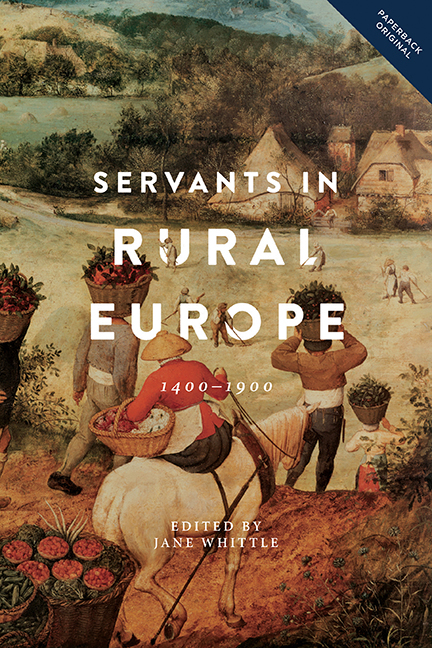Book contents
- Frontmatter
- Contents
- List of Figures
- List of Tables
- Note on Terminology
- List of Contributors
- Introduction: Servants in the Economy and Society of Rural Europe
- 1 The Employment of Servants in Fifteenth- and Sixteenth-Century Coastal Flanders: A Case Study of Scueringhe Farm near Bruges
- 2 The Institution of Service in Rural Flanders in the Sixteenth Century: A Regional Perspective
- 3 A Different Pattern of Employment: Servants in Rural England c.1500–1660
- 4 Female Service and the Village Community in South-West England 1550–1650: The Labour Laws Reconsidered
- 5 Life-Cycle Servant and Servant for Life: Work and Prospects in Rural Sweden c.1670–1730
- 6 Servants in Rural Norway c.1650–1800
- 7 Rural Servants in Eighteenth-Century Münsterland, North- Western Germany: Households, Families and Servants in the Countryside
- 8 Rural Servants in Eastern France 1700–1872: Change and Continuity Over Two Centuries
- 9 The Servant Institution During the Swedish Agrarian Revolution: The Political Economy of Subservience
- 10 Farm Service and Hiring Practices in Mid-Nineteenth-Century England: The Doncaster Region in the West Riding of Yorkshire
- 11 Dutch Live-In Farm Servants in the Long Nineteenth Century: The Decline of the Life-Cycle Service System for the Rural Lower Class
- 12 Rural Life-Cycle Service: Established Interpretations and New (Surprising) Data – The Italian Case in Comparative Perspective (Sixteenth to Twentieth Centuries)
- Select Bibliography
- Index
- People, Markets, Goods: Economies and Societies in History
8 - Rural Servants in Eastern France 1700–1872: Change and Continuity Over Two Centuries
Published online by Cambridge University Press: 18 April 2018
- Frontmatter
- Contents
- List of Figures
- List of Tables
- Note on Terminology
- List of Contributors
- Introduction: Servants in the Economy and Society of Rural Europe
- 1 The Employment of Servants in Fifteenth- and Sixteenth-Century Coastal Flanders: A Case Study of Scueringhe Farm near Bruges
- 2 The Institution of Service in Rural Flanders in the Sixteenth Century: A Regional Perspective
- 3 A Different Pattern of Employment: Servants in Rural England c.1500–1660
- 4 Female Service and the Village Community in South-West England 1550–1650: The Labour Laws Reconsidered
- 5 Life-Cycle Servant and Servant for Life: Work and Prospects in Rural Sweden c.1670–1730
- 6 Servants in Rural Norway c.1650–1800
- 7 Rural Servants in Eighteenth-Century Münsterland, North- Western Germany: Households, Families and Servants in the Countryside
- 8 Rural Servants in Eastern France 1700–1872: Change and Continuity Over Two Centuries
- 9 The Servant Institution During the Swedish Agrarian Revolution: The Political Economy of Subservience
- 10 Farm Service and Hiring Practices in Mid-Nineteenth-Century England: The Doncaster Region in the West Riding of Yorkshire
- 11 Dutch Live-In Farm Servants in the Long Nineteenth Century: The Decline of the Life-Cycle Service System for the Rural Lower Class
- 12 Rural Life-Cycle Service: Established Interpretations and New (Surprising) Data – The Italian Case in Comparative Perspective (Sixteenth to Twentieth Centuries)
- Select Bibliography
- Index
- People, Markets, Goods: Economies and Societies in History
Summary
Village communities in many parts of Europe throughout the early modern period contained a significant number of servants. Historians have underlined the importance of rural service within the context of the late-marrying demographic system that was in place in much of north-western Europe, stressing the fact that most worked in service between their departure from home and economic independence at marriage. In the case of eighteenth- and nineteenth-century France, most of the work on rural servants can be found in regional monographs in demographic and rural history published during the 1970s and 1980s. While there are several books on urban servants in the eighteenth century, there is only a single chapter in one book dating from 1982 that attempts to synthesize work on rural service in France, and little has been published since that deals specifically with rural servants or service. Indeed French rural servants are conspicuously absent from the multivolume publications of the Servant Project. Despite this lack of a significant body of recent work on the subject, it is nevertheless clear that rural service was an important source of labour in the French countryside throughout the Ancien Regime and during the nineteenth century, and played a significant role in the transition from childhood to adulthood, as elsewhere in Europe.
This chapter analyses several demographic and social characteristics of rural service during the eighteenth and nineteenth centuries in the French region that would become the department of the Cote d'Or during the French Revolution. Because relatively few (but perhaps more than historians think, as we will see below) remained in service for longer than about a decade, the traditional tools of demographic history (parish registers, family reconstruction) are of limited use. The absence of servants from parish registers explains why most of the work on the demography of servants has been based on censuses. This chapter is no different and is largely based on two nominal censuses that were prepared about seventy-five years apart, that of 1796 and that of 1872. Both censuses group households together and provide the name, age and occupation of those listed (all inhabitants in the census of 1872, those twelve and over in the census of 1796).
- Type
- Chapter
- Information
- Servants in Rural Europe1400–1900, pp. 149 - 166Publisher: Boydell & BrewerPrint publication year: 2017

